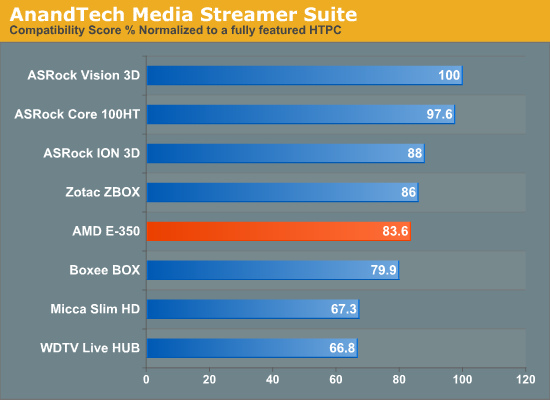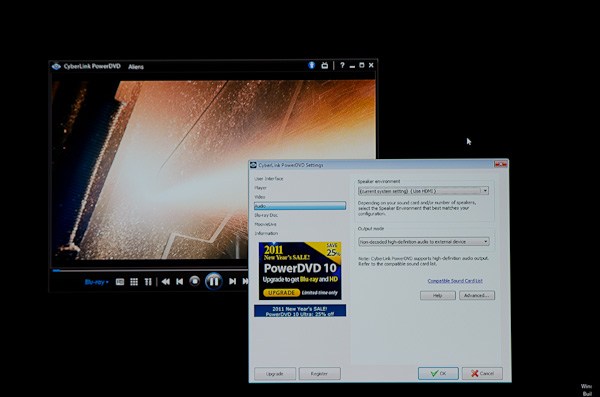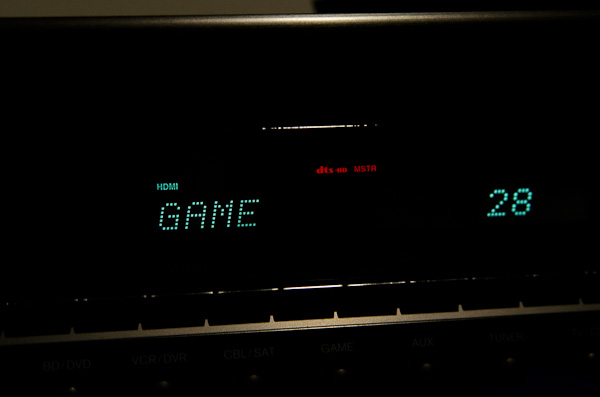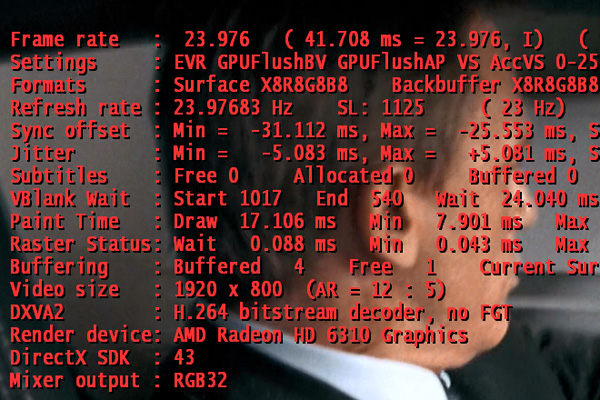The Brazos Review: AMD's E-350 Supplants ION for mini-ITX
by Anand Lal Shimpi on January 27, 2011 6:08 PM ESTVideo Decode Capabilities: Is Brazos the New ION?
While Atom may have been the right product at the right time, it was a very conservative architecture paired with a very conservative platform. For netbooks and nettops Intel chose to assume no risk at all, pairing Atom with the proven 945 chipset. As a result, it left a lot of room for innovation - something NVIDIA saw and capitalized on with ION.
While VIA created the mini-ITX form factor, it was really NVIDIA that made it interesting. The first mini-ITX ION platforms gave you almost everything you needed to build a fully capable HTPC. For video playback, with NVIDIA’s GPU (or at least its fixed function decode pipeline) doing the heavy lifting, the fact that you had an anemic Atom a couple centimeters away didn’t matter. The problem with ION is that it had no future. Without a DMI license, NVIDIA would not be able to build future versions of ION for Atom’s successors. Even after the settlement it’s unlikely we will ever see modern versions of ION, especially considering that Intel’s 2011 Atom platform (Cedar Trail) will finally integrate H.264 decode acceleration in Q4.
Where Intel is conservative, AMD will innovate. Brazos adds a number of advantages from a media standpoint over Atom. There’s native HDMI support and a full implementation of AMD’s UVD3 decode engine supporting hardware H.264, VC-1 and MPEG-2 acceleration. Although both of these advantages are also enjoyed by ION the next feature isn’t. Brazos supports Dolby TrueHD and DTS-HD MA bitstreaming over HDMI. From a feature standpoint, Brazos is even more complete than ION.
I ran MSI’s Brazos board through our Media Streaming compatibility suite. Below is Brazos’ compatibility score compared to the other devices and HTPCs we’ve put through the suite:

Failed Tests
- 1080p60 60 fps L5.1 H.264
- L5.1 H.264 (16 reference frames)
- FLAC, ASS Subs - High CPU Utilization
- HD Real Media
- Deinterlacing
Numerically, Brazos actually falls behind ION. Allow me to explain why. Our Media Streaming suite tests virtually everything you might throw at a HTPC. When it comes to the most commonly found content, Brazos excels. It can handle Blu-ray discs (although there’s no Blu-ray 3D support), it can deal with 1080p x264s commonly found online and it even accelerates Flash video (more on this later). Brazos’ UVD3 however is tied to clock speed, and the GPU clock of the Radeon HD 6310 is pretty low at 500MHz. As a result, Brazos fails certain tests. The platform is incapable of accelerating and playing back 1080p60 H.264 video. Very little content falls into this category, however if you want to play it you can’t on Brazos. The good news is 1080i60 works just fine.
Brazos’ GPU also fails all of our deinterlacing tests, something we noticed in reviews of AMD’s entry level GPUs. The higher end models don’t have an issue here but the lesser equipped models do. Again, chances are that you won’t want to watch interlaced content on your Brazos HTPC so this is likely not a big issue.
The other shortcomings are videos with components that aren’t accelerated by UVD3. For example, HD Real Video chugs on Brazos as does our heavy FLAC + ASS subs test. If you’re playing non-3D Blu-ray content or 1080p24 x264s you find on the web, Brazos will easily fit the bill. It’s the more eccentric content that you’ll run into CPU limitations with.
Since the Radeon HD 6310 is derived from AMD’s desktop GPUs we get full 23.976 fps support when you select 23Hz in AMD’s Catalyst driver:
Selecting 24Hz yields a 24.000Hz refresh rate.
As I mentioned earlier bitstreaming both TrueHD and DTS-HD MA are supported over HDMI:














176 Comments
View All Comments
Scootiep7 - Friday, January 28, 2011 - link
The major problem is that Intel's drivers are flat out junk for anything Gaming/HTPC related. With ULV Sandy Bridge, you'll be paying three times as much for a complete system that performs less than half as well on most of the stuff you want to do with it in this market segment.redraider89 - Thursday, May 4, 2017 - link
Yes, yes it is.redraider89 - Thursday, May 4, 2017 - link
An unreleased processor can't beat an existing processor. So, yes, yes it is. It's absurd when people think just because they repeat their no's that gives what they are saying more legitimacy.Marlin1975 - Thursday, January 27, 2011 - link
Talk about good for a first try.Think about it; AMDs first shot into this area is as good or way better than the much updated Atom from intel.
Anand can you ask when amd thinks they will be able to move this to 32nm? Seems the design is good just needs updated shrinkage to increase the Mhz.
Also since this will not be in a netbook/laptop can you overlclock???
nitrousoxide - Thursday, January 27, 2011 - link
No 32nm Brazos parts, they will come directly with 28nm next year. Yes, 4 bobcat cores, VLIW 4D architecture GPUs, 2x performance at minimum or even higher if AMD gives it Turbo Boost feature.Overclocking doesn't make any sense on this chip, because no matter how you overclock it, the chip cannot do the things it can't do at default clock. it simply brings you more power consumption.
Marlin1975 - Thursday, January 27, 2011 - link
Overclock for the desktop not the netbook.Could make some items go from unusable to usable as a low power desktop replacement.
I like to see what would happen and what would help the most or not.
nitrousoxide - Thursday, January 27, 2011 - link
Try AMD Overdriveknedle - Saturday, January 29, 2011 - link
You can overclock everything (even a notebook), but since the board didn't support it, it's much harder. ;)I'm sure someone will release overclockable boards, it's just the matter of time.
Gigantopithecus - Thursday, January 27, 2011 - link
...ETA for Brazos mini-ITX availability in retail channels?I can't think of a reason to buy anything, be it a netbook or nettop or htpc, with an Atom in it given Brazos's performance and power consumption. Can't wait to start building Brazos systems!
codedivine - Thursday, January 27, 2011 - link
I am a little confused. If I put a graphics card in the x16 slot, will it run at x4 PCIe 2.0 speeds or x16 PCIe 2,0 speeds?